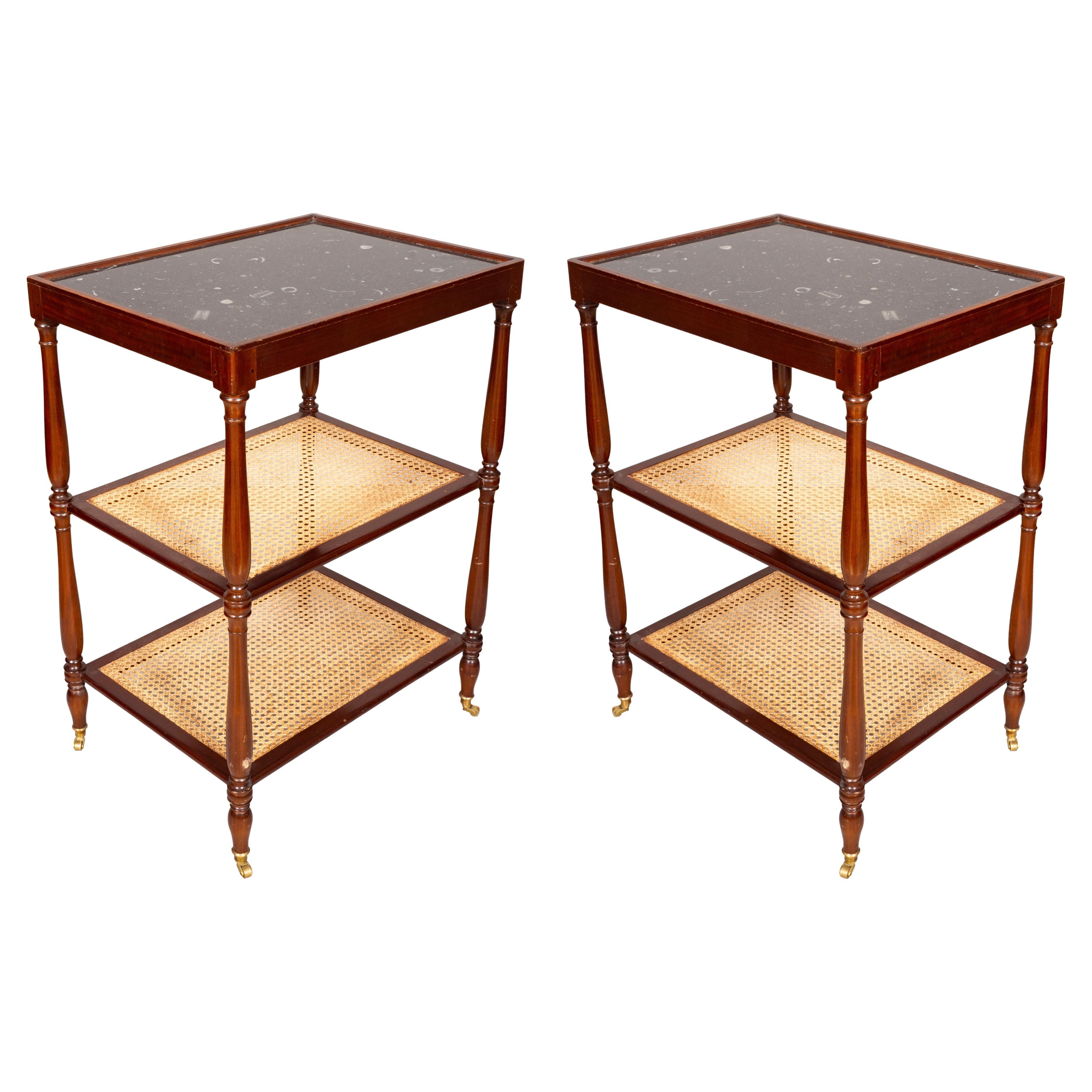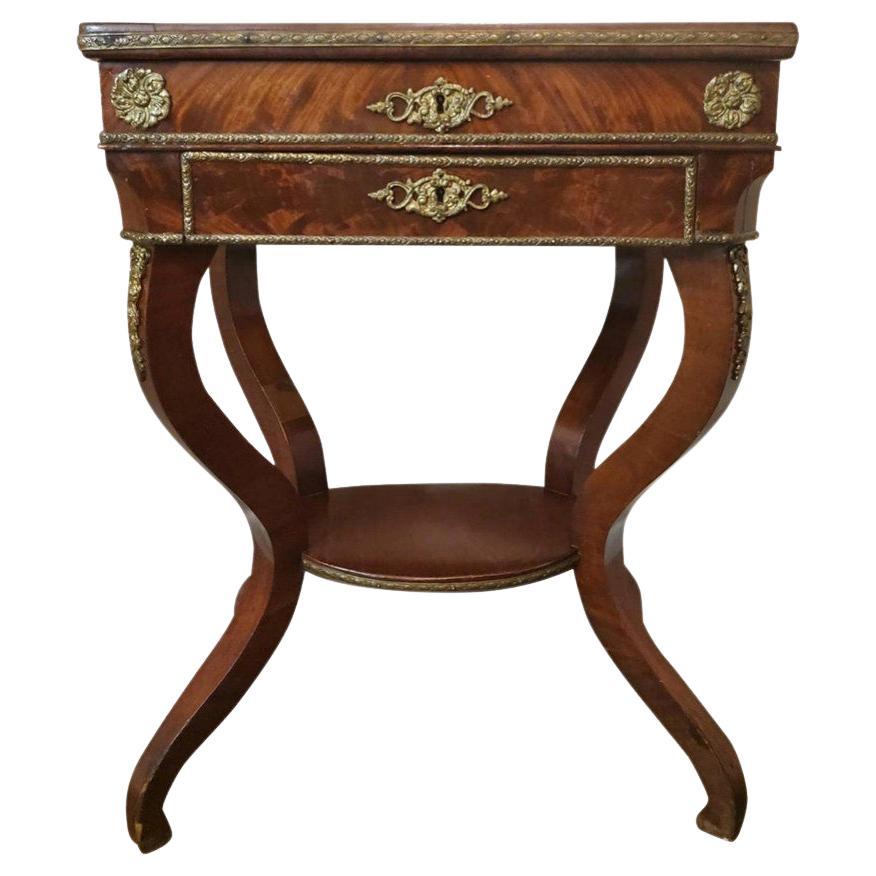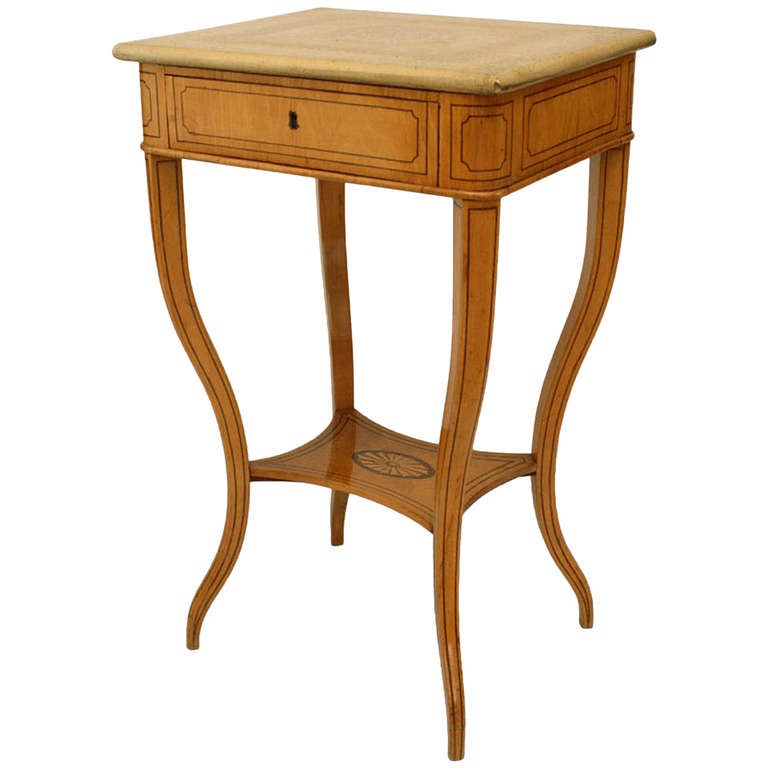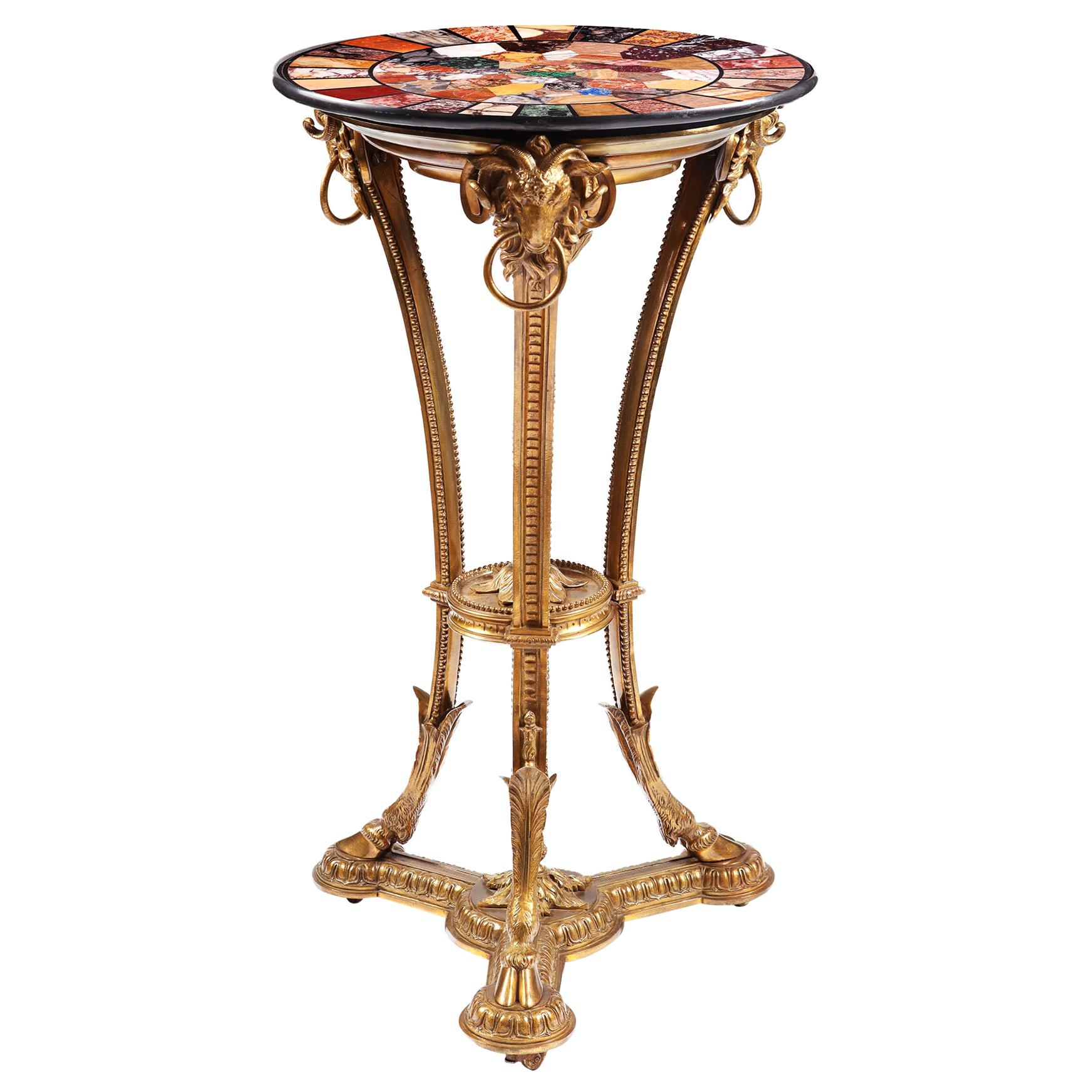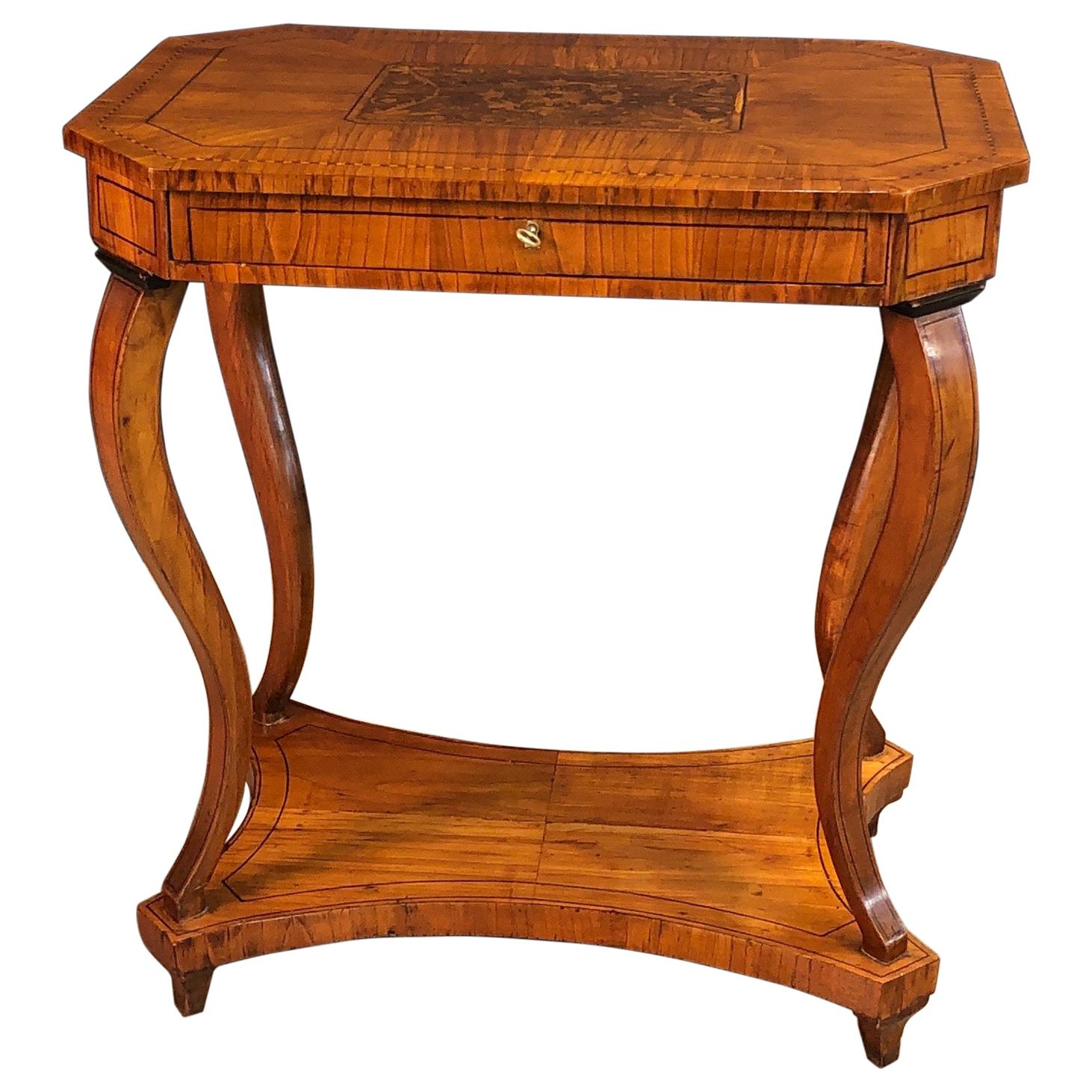Items Similar to Charles X Walnut and Marble Drinks Table or Rafraichissoire
Want more images or videos?
Request additional images or videos from the seller
1 of 17
Charles X Walnut and Marble Drinks Table or Rafraichissoire
About the Item
Square gray and white marble top with circular bottle holders with tole liners over a frieze with small drawer, turned legs and two lower shelves, turned feet.
- Dimensions:Height: 28.38 in (72.09 cm)Width: 17.5 in (44.45 cm)Depth: 17.25 in (43.82 cm)
- Style:Charles X (Of the Period)
- Materials and Techniques:Marble,Walnut
- Place of Origin:France
- Period:1830-1839
- Date of Manufacture:1835
- Condition:Wear consistent with age and use. Imperfections.
- Seller Location:Essex, MA
- Reference Number:1stDibs: LU838127909062
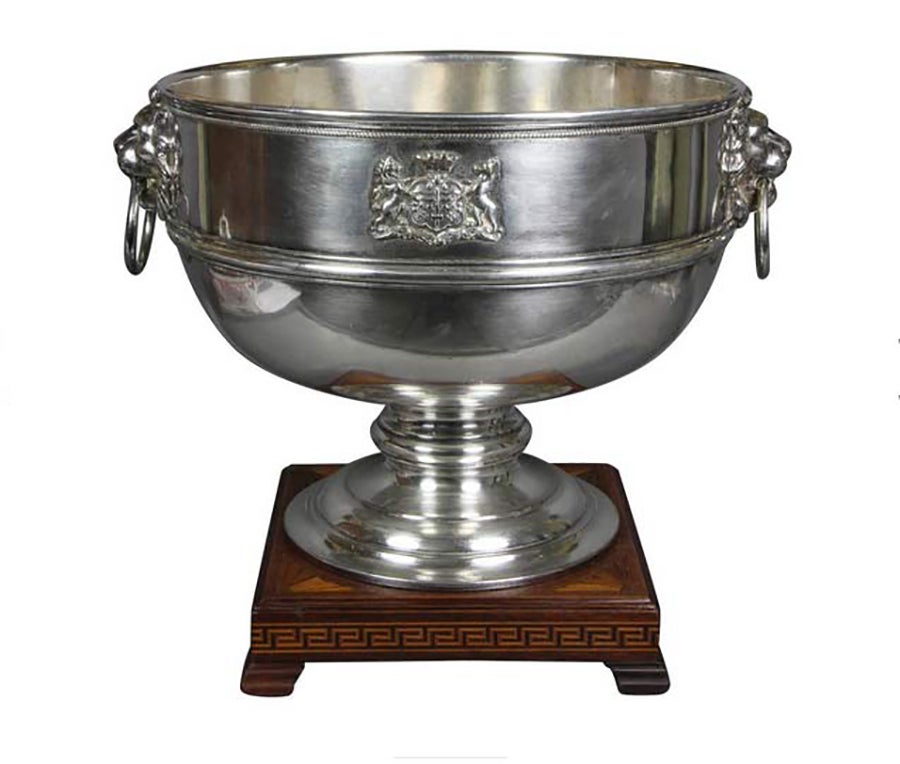
About the Seller
4.9
Gold Seller
These expertly vetted sellers are highly rated and consistently exceed customer expectations.
Established in 1985
1stDibs seller since 2007
813 sales on 1stDibs
Typical response time: 2 hours
Associations
The Art and Antique Dealers League of America
- ShippingRetrieving quote...Ships From: Essex, MA
- Return PolicyA return for this item may be initiated within 14 days of delivery.
More From This SellerView All
- Pair of Charles X Style Mahogany TablesLocated in Essex, MAEach with rectangular grey marble inset tops over two conforming caned shelves, raised on turned legs and casters.Category
Antique 1820s European Charles X End Tables
MaterialsCane, Mahogany
- Italian Baroque Style Walnut TableLocated in Essex, MARectangular top with old crack over a trestle base with wrought iron stretchers. Old elements.Category
Antique 17th Century Italian Baroque End Tables
MaterialsWalnut
- George III Style Burl Walnut and Mahogany China Table Attributed to GillowLocated in Essex, MAFinely made with a wonderful burl veneer top of serpentine shape raised on cluster column legs headed by blind fretwork and fretwork spandrels. The ...Category
Antique 1760s English Chinese Chippendale Tables
MaterialsMahogany
- Regency Style Mahogany and Giltwood TableLocated in Essex, MACircular banded top over a conforming frieze supported on three ebonized and gilt wood legs joined by a plinth base raised on Greek scroll feet.Category
Antique 1810s Regency End Tables
MaterialsMahogany
- Edwardian Mahogany and Crossbanded End TableLocated in Essex, MAWith rectangular top with crossbanding and 3/4 brass gallery over a conforming lower shelf, the sides with brass roundels ending on platform legs.Category
Antique 1890s English Edwardian End Tables
MaterialsOther
- Vintage Brass and Mirrored End TableLocated in Essex, MASquare mirror top with gallery and cast brass border on square section tapered legs and X form stretcher.Category
Mid-20th Century European Neoclassical End Tables
MaterialsBrass
You May Also Like
- 19th C. French Charles X Restoration Period Sewing Stand Work TableLocated in Forney, TXA scarce period Charles X (1818-1834) French Restoration mahogany travailleuse sewing (thread stand - side table - jewelry dressing table) with light, warm, beautifully aged patina. Born in France in the early 19th century, almost certainly Parisian work, exquisitely hand-crafted, this exceptionally executed example features ornate gilt bronze ormolu mounts, escutcheons, and elaborate gilt metal trim. Having a highly figured light mahogany hinged lid top, lifting open to reveal a striking finished interior with divided compartments and original inset mirror plate. The conforming rectangular case fitted with a faux drawer front over a dovetailed drawer with sectioned interior. Elegantly rising on oval-shaped medial shelf stretcher-joined curvacious legs. Dimensions (approx): 27" High, 20" Wide, 13.5" Deep Stunning light almost blonde antique mahogany coloring and mellow warm tone, superb wood grain detail, and charming, beautifully aged patina over the whole. Great shape overall. Retaining original antique character marks, wear consistent with age and indicative of minimal use, nothing that detracts from the aesthetics or functionality, but only adds to the overall authenticity, refined elegant warmth, luxurious sophistication, and cozy unpretentious rustic elegance. Delivered cleaned, hand waxed, polished French patina finish, ready for immediate use and generational enjoyment! What is Charles X style: The comte d’Artois – or Charles X - was the son of the dauphin Louis-Ferdinand de Franc and Marie-Josèphe de Saxe. He succeeded his two brothers Louis XVI and Louis XVIII and became the King of France in 1824. Thirty years after the French Revolution, he wanted to embody the return of monarchy and became the leader of the catholic party . As the previous kings, he was crowned in 1825 but he was soon overthrown by the revolution in July, 1830, called "Trois Glorieuses". He left then for England, Scotland, Prague and Istria where he died in 1836. Charles X style lasted from 1818 to 1834 and happened during the Bourbon Restoration (French Restoration). This style did not replace totally the style of furniture from the French Empire but it was different from the formalism in the Napoleonic era, during which strictness and simplicity were inspired by Greco-Roman art. Indeed, artistic fields flourished. In terms of furniture, this renewal was suggested by the softening of shapes. Even though the simple aspect from the French Empire was still visible, shapes became curvier with volutes and arabesques. Another distinction is the loss of the massive aspect of furniture and the decrease of dimensions in order to decorate smaller appartments. Handling ability and comfort were key-words in the making of furniture. Apartments had essential elements such as chests of drawers, big rounded tables in the dining room, desks or secretaries, armoires and even dressing tables, comfortable fainting couches in the living room, small tables, pedestal tables, as well as gondola chairs. The wavy aspect of the latters certainly represent Charles X style the best. One of the most emblematic features of this style is the use of bois clairs – light woods in warm blond tones - and indigenous woods that are varnished in order to highlight the grains. Bird's-eye maple, ash trees, plane trees, yew trees, beech trees, olive trees and cedar trees were most likely to be used. Indeed, at the beginning of the 19th century dark woods were hard to find. In 1806, the Napoleon’s Continental System was established in order to ruin the United Kingdom by preventing the country from any business with the rest of Europe. Therefore craftsmen had to find alternatives from mahogany which was the most commonly used material at this time. After 1815, the import of wood was even more difficult because of peace treaties and the European political situation, which contributed to the popularity of the bois clairs and indigenous woods. The furniture was often decorated with fine inlays made out of dark wood representing foliage, which contrasted with the veneer. Even though these patterns can look like bronze decorations from the Empire era, they were far more simple and did not represent any military or mythological attributes. On the tables, trays were sometimes made out of marble as in the French Empire, but it was often put aside and inlaid veneer, Verre Eglomisé – a type of glass with a mirror finish –, mirror or porcelain from Sèvres or Paris were more likely to be used. Decorative elements from the Monarchy were highly appreciated again as they suggested luxury. Indeed, marquetry work was particularly fashionable - Boulle marquetry thrived around 1820 as the works of the Levasseur family can show. In the same way, draperies and trimmings referred to the monarchist splendour. Fabrics were often white – the traditional colour of the Bourbons – or light coloured as oppposed to the typical green from the Napoleonic era. One of the most symbolic figures from this period of time might be Jean-Jacques Werner (1791-1849), a cabinetmaker who worked for prestigious clients such as the Duchesse de Berry who was Charles’s step-daughter. His works can be seen at the Musée des Arts Décoratifs and at the Grand Trianon in the Palace of Versailles. The duchess’s appartments situated at the pavillon de Marsan and at the Palais de Saint Cloud illustrate Charles X style the best with furniture made out of bois clairs and ornamented with dark wood patterns or fine gold decorations. Chales X style allows a transition between the sobriety of the Empire style and the abundant aspect of Louis-Philippe style. The gothic style started at this time through the "style à la cathédrale", inspired by religious architecture, which thrived from 1827 to 1830. Indeed, at the beginning of the 19th century, Romanticism put the spotlight on the Middle Ages. Cabinetmakers were not inspired by the medieval furniture but rather by architectural elements of churches and cathedrals. For instance the backs of chairs were decorated with arches shaped like rib and serration. In the same way, before Charles X abdicated, pieces of furniture were made out of dark woods – such as mahogany, which was used again in France – and were inlaid with light wood. Romanticism also influenced the layout of furniture in appartments to suggest movement through a mix of various styles, various shapes and various sizes, as opposed to the static aspect of Neoclassicism. The start of industrialisation and mechanisation also influenced this style as early technical developments led to the production of pieces of furniture in series. Credit: Marc Maison Bibliography: FANIEL Stéphane (Dir.), Le Dix-neuvième Siècle Français, Collection Connaissance des Arts, 1957, Hachette SASSONE, Adriana Boidi, Furniture from Rococo to Art Deco, 2000, Evergreen -- Extremely versatile: As warm and attractive as it is useful, this remarkable antique table having the ideal size and small proportions for a variety of different uses, including as a side table, accent or occasional table, tall sofa...Category
Antique Early 19th Century French Charles X End Tables
MaterialsBronze, Ormolu
- Midcentury Made Organic Modern Wine or End Table with Walnut & Bark Table TopLocated in Lisse, NLHandcrafted and organically beautiful 1950s table. This handcrafted table from the midcentury era is both beautiful and functional. The natural material tabletop is made of a stunning slice of timber and it even comes with the original bark. The grain in this tree trunk top really is a joy to look at and the color (or patina) makes it even more desirable. The mint condition legs come with equally mint metal feet that can tilt a little which makes this table level...Category
Mid-20th Century European Mid-Century Modern End Tables
MaterialsMetal
- French Charles X Maple and Marble End TableLocated in New York, NYFrench Charles X maple and inlaid end table with decorated white marble top.Category
Antique 19th Century French Charles X End Tables
MaterialsMarble
- Pietra Dure Specimen Marble and Bronze TableLocated in London, by appointment onlyA fine 19th century Pietra dure marble inlaid circular table containing 65 rare marbles and precious stones. Measures: 19 ins diameter 48cm 33.5 ins high 85cm This specimen marble table has a total of 64 unique samples of rare stones gathered from across Europe and deep into Africa, the Middle East and Russia. Stone inlay table; 1 - Brecha da Arrábida 2 - Breccia di Seravezza 3 - Giallo Tigrato 4 - Rosso Levanto 5 - Roman Baixas Breccia 6 - Cork Red Marble 7 - Giallo Antico 8 - Breccia Corallina Giallastra 9 - Yava Onyx 10 - Broccatellone 11 - Breccia di Settebasi, Semesanto 12 - Giallo di Siena 13 - Greek Antique Green / Patricis Green 14 - Braccia di stranezza 15 - Fior di Pesco 16 - Norwegian Rose Marble...Category
Antique Mid-19th Century European Grand Tour End Tables
MaterialsPorphyry, Marble, Bronze
- Charles X Walnut Inlaid Side TableLocated in Westwood, NJAn unusual French Charles X walnut and fine marquetry inlaid one drawer side table with a shelf stretcher base,Category
Antique 1820s French Charles X End Tables
MaterialsWood
- Zora Drink Table in Polished Bronze by Karl GecklerBy Karl GecklerLocated in Chicago, ILA Zora side table by Chicago artist Karl Geckler in polished bronze with a guitar-pick shaped bronze tinted glass top. Alternative finishes available. Inquire for details. Karl Geckler works as an interdisciplinary sculptor, architect, and designer based in Chicago, Illinois. He graduated with a Bachelor of Architecture degree from Virginia Polytechnic Institute and later studied astronomy and physics before pivoting to art. His scientific background influenced his artwork greatly and he is inspired by geometry and biological forms, nature and medical diagrams...Category
21st Century and Contemporary American Mid-Century Modern End Tables
MaterialsBronze
Recently Viewed
View AllMore Ways To Browse
Small Antique Walnut Table
Small Marble Table Antique
Antique Drink Table
Antique Drinks Table
Drinks Table Antique
Antique Small Marble Top Table
French Table Charles X
Small Drink Table
Small Drinks Table
White Antique Shelves
Antique White Shelves
Walnut Drink
Two Drawer Turned Leg Table
Small White End Tables
Small End Tables With Drawer
Circular Shelves
Small Drink Tables
Circular Table Drawer
